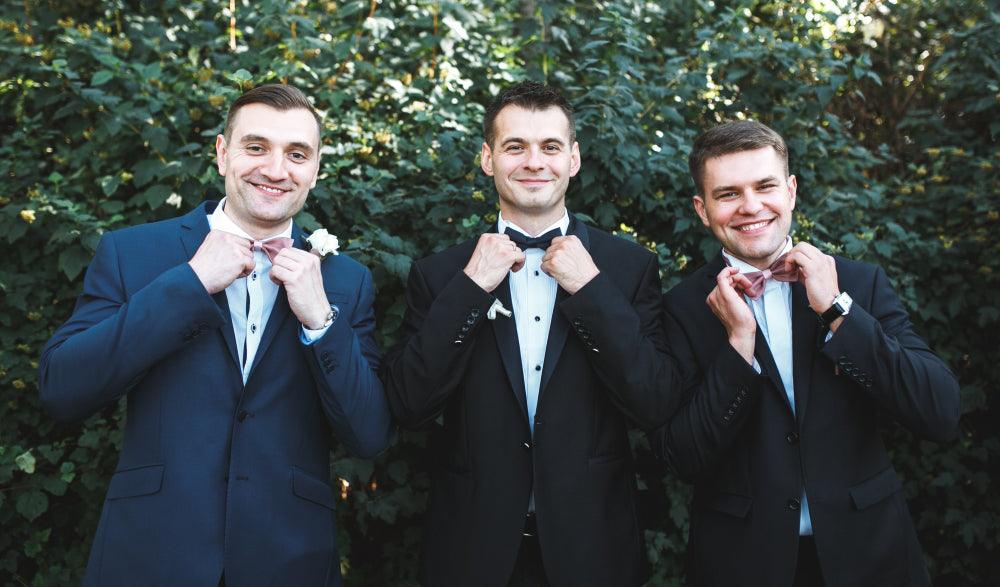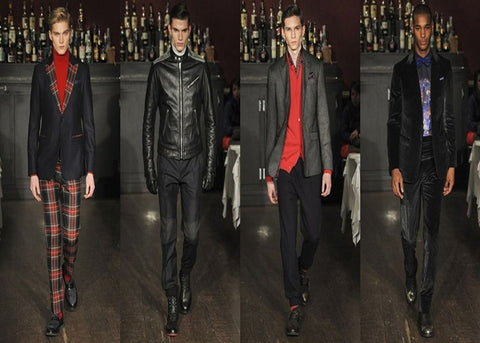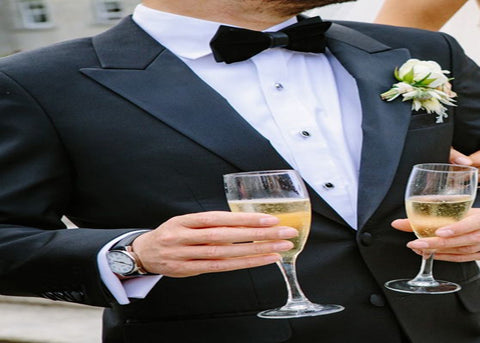
What Is the Difference Between a Tux and a Suit?
Share
Ever mixed up tuxedos and suits? You're not alone. Let's break it down - no fancy terms, just the essentials. Tuxes and suits, while both sharp, have their own scenes: tuxes for the black-tie, suits for less formal vibes. It's about the details: satin on tuxes, versatility in suits.
Choosing right depends on the event, fabric, and fit. We'll share real talk on picking the perfect fit, making sure you look top-notch no matter the occasion.
Key Takeaways
- Tuxedos and suits are distinguished by their origins, with tuxedos representing the pinnacle of evening formality and suits offering versatile elegance for various occasions.
- Key features such as satin lapels, a cummerbund or waistcoat, and patent leather shoes are exclusive to tuxedos, while suits are characterized by their diverse styles and materials.
- The choice between a tuxedo and a suit largely depends on the event's formality, with tuxedos being reserved for black-tie events and suits for business or casual settings.
- Shirts worn with tuxedos typically feature a wingtip or turndown collar and are often white, whereas suit shirts can vary in color and design, reflecting personal style and occasion.
- Fashion houses like Etro and Brioni are redefining the boundaries of classic menswear, infusing traditional silhouettes with innovative fabrics and modern sensibilities.
Exploring the World of Tuxedos
The origins and evolution of the tuxedo
The tuxedo, originally a relaxed alternative to tailcoats for elite gatherings, has become a formal wear icon, evolving from classic black and white to include satin and velvet. Its journey:
- Debuted as a dinner jacket in the late 19th century
- Became essential for special occasions by the early 20th century
- Experimented with colors and fabrics in the mid-1900s
- Embraced designer and gender-neutral styles recently
This evolution reflects changing fashion and social norms, making the tuxedo a versatile staple in men's formal wear. It's not just about "what is the difference" between tuxes and suits but showcasing style and challenging norms, from white dinner jackets to mens rental formal wear. Keeping it straightforward, the tuxedo's story is about sophistication, answering all those tuxedo questions with a nod to tradition and modern flair.
Occasions typically warranting a tuxedo
Tuxedos are the go-to for top-tier events where looking sharp is a must. They're the MVPs for black-tie affairs, swanky weddings, opera nights, state dinners, and any red-carpet moment. Here's the rundown on when to suit up in a tux:
- Traditional black tie and gala shindigs
- Evening I do's in the wedding market
- High culture outings like the opera or ballet
- Official state functions and ceremonies
- Glitzy award shows and premieres
Knowing when to rock a tux is key to nailing social etiquette and standing out with class. With its satin lapels, bow tie, and often a white dinner jacket option, a tux sets you apart from the standard suit crowd, matching the event's vibe perfectly. Whether it’s figuring out "what is the difference" between formal wear styles, tackling tuxedo questions, choosing between mens rental formal wear or owning, or decoding dress codes like traditional vs. tropical black tie, it’s all about fitting in while standing out. Let's keep this chat as easy as getting advice over coffee, focusing on those physical differences and making sure every special occasion is met with the right level of finesse.
Key features that define a tuxedo
A tuxedo isn't just any suit; it's the epitome of men's formal style, spotlighting satin lapels, buttons, and trouser side stripes for that signature look. You'll find them in classic black or midnight blue, often paired with a white shirt featuring wingtip or turndown collars, and not forgetting the polished patent leather shoes. Here's what sets a tux apart:
- Satin for that sleek edge
- Black or midnight blue as the go-to colors
- Waistcoats or cummerbunds to dial up the formality
- Patent leather shoes to cap off the look
This gear is all about honoring those big moments, whether it’s a traditional black tie affair, a beachfront tropical black tie, or daytime weddings. The dive into men's rental formal wear or picking the right color tuxedo simplifies with these pointers. Michael Armstrong, our go-to staff writer, breaks down the essentials from what makes a white dinner jacket stand out to navigating the wedding market, long ties, and the differences in formal wear styles. Whether it's owning your tux or hitting the rental shop, understanding these basics transforms tuxedo questions into confidence, reflecting a blend of personal flair and societal norms in formal wear.

The Classic Elegance of Suits
Various types of suits and their appropriate settings
Suits tailor every occasion, from seersucker at summer parties to classic navy for the office. They've evolved beyond work, with blazers and trousers now fitting for both meetings and dinners. Key pairings include:
- Business: Dark wool suits
- Semi-Formal: Pinstripes or light wool
- Casual: Linen or seersucker
- Summer: Light cotton
Picking a suit means aligning with the event while expressing personal style. Michael Armstrong's posts dive into formal wear differences, from white dinner jackets for special events to the practicality of rental tuxedos and the style of bow ties. It's about matching occasion to attire, making every moment a statement.
Identifying the Key Differences: Tuxedo vs Suit
Detailed comparison of fabric, design, and usage
Tuxedos vs. suits boils down to fabric, design, and occasion. Tuxedos, with their silk, satin, or wool-cashmere blends, are for high-end events, featuring satin lapels and stripes that scream elegance. Suits, made from cotton, linen, or wool, are the versatile choice for daily to semi-formal events, offering a variety of styles.
Tuxedos are the go-to for black-tie affairs, while suits fit a wider range of settings from offices to daytime weddings. Here’s the essence:
- Tuxedos: Luxe fabrics, formal design for special occasions.
- Suits: Versatile materials and styles for everyday to semi-formal.
The significance of satin in tuxedos
Satin isn't just a fancy detail in tuxedos; it's what elevates them above standard formal wear. This glossy fabric contrasts sharply with the tuxedo's matte parts, spotlighting the lapels, buttons, and trouser stripes. Rooted in tradition, satin's role is both aesthetic and practical, offering durability where it counts.
- Lapels: They catch the light with a satin sheen, marking a tuxedo's upscale vibe.
- Buttons: Decked in satin, these add refined elegance.
- Side Stripes: Satin stripes down the trousers sharpen the look, ensuring you stand out.
Satin underlines a tuxedo's role as top-tier mens formal wear, fit for grand events. Whether it's a white dinner jacket for a tropical black tie affair or a classic black for traditional settings, the material's use is a testament to the tuxedo's special status.
This distinction is crucial in the mens rental formal wear market, where understanding the difference between suit and tux plays into making the right choice for occasions like daytime weddings or formal galas.
When to wear a tuxedo vs a suit fabric, and buttoning based on the event's formality
Understanding when to wear a tuxedo vs. a suit based on the event's formality is crucial for making the right impression. Tuxedos are typically reserved for 'black tie' events, which denote a high level of formality. These include galas, formal dinners, and weddings that specify black tie dress code. On the other hand, suits are more versatile and can be worn to a variety of occasions, ranging from business meetings to casual social gatherings.
The choice between a tuxedo and a suit also hinges on the time of day. Tuxedos are traditionally worn for evening events, while suits can be appropriate for both daytime and nighttime functions. Here's a quick guide to help you decide:
- Daytime events: Business suit
- Evening business events: Dark, conservative suit
- Semi-formal evening events: Dark suit or a tuxedo, depending on the specific event guidelines
- Formal evening events ('black tie'): Tuxedo
Remember, the key to dressing appropriately is to understand the expectations of the event and to choose your attire accordingly. While the tuxedo exudes a sense of timeless elegance for the most formal of occasions, the suit offers flexibility and can be adapted to suit a wide range of events with varying degrees of formality.
Shirt Showdown: Tuxedo vs Suit

Difference in shirts worn with tuxedos and suits
In the sartorial ring of the Shirt Showdown: Tuxedo vs Suit, the contenders are distinct in their style and formality. The tuxedo shirt, often known as a formal or dress shirt, is typically white and made of a more luxurious fabric such as pique or a fine cotton. It features unique elements like a wingtip or turndown collar and may include pleats or a bib front for added sophistication.
Suits, on the other hand, allow for a broader range of shirt options. The suit shirt can vary in color, pattern, and fabric, catering to personal taste and the occasion's demands. Unlike the tuxedo shirt, it usually has a standard pointed collar and lacks the distinctive front bib.
Here's a quick comparison:
- Tuxedo Shirt: White, luxurious fabric, wingtip/turndown collar, pleated bib front.
- Suit Shirt: Varied colors/patterns, choice of fabric, standard pointed collar, no front bib.
Conclusion
In the intricate dance of formality and self-expression, tuxedos and suits each play their unique role in a man's wardrobe. The tuxedo, with its satin sheen and strict codes, is the epitome of ceremonial elegance, reserved for the most formal of occasions.
Suits, on the other hand, offer a versatile canvas for personal style, adapting to various settings with a range of fabrics and cuts. Modern fashion continues to challenge and reinterpret these classic garments, infusing them with new life and blurring the lines of traditional menswear.
From the bold creativity of Etro's capsule collection to the deconstructed sophistication of Lanvin, the evolution of these pieces reflects a broader shift in our understanding of luxury and comfort.
Whether it's the sharp silhouette of a tuxedo or the tailored ease of a suit, the power of these ensembles lies in their ability to transform not just the appearance, but the very essence of the wearer.
As we embrace the future of fashion, the mystique of tuxedos and suits remains, not as mere clothing, but as symbols of identity and culture.
Frequently Asked Questions
What are the key features that define a tuxedo?
Tuxedos are characterized by satin lapels, a satin stripe down the trouser leg, and a bow tie. They are typically worn with a formal white shirt, which may have pleats or a bib front, and are reserved for black tie events.
Can suits be worn for the same occasions as tuxedos?
Suits are more versatile than tuxedos and can be worn for a wide range of occasions, from business meetings to casual events. Tuxedos are reserved for formal events like weddings, galas, and black-tie affairs.
What distinguishes the fabric used in tuxedos from that of suits?
Tuxedos often use finer, more luxurious fabrics such as wool barathea, grosgrain, or silk, and feature satin details. Suits are made from a variety of fabrics, including wool, cotton, linen, and synthetic blends, without satin accents.
Why is satin a significant feature in tuxedos?
Satin adds a distinctive sheen and formal touch to tuxedos, setting them apart from suits. It's used on the lapels, buttons, pocket trim, and side stripes of the trousers, highlighting the garment's elegance for special occasions.
When should I choose to wear a tuxedo over a suit?
A tuxedo should be chosen for events that specify a black-tie dress code or are highly formal, such as evening weddings, balls, and formal dinners. A suit is more appropriate for business settings, semi-formal events, and everyday professional wear.
Are there different shirt options for tuxedos and suits?
Yes, tuxedo shirts typically have a wing or turndown collar, pleated fronts, and are worn with cufflinks and studs. Suit shirts are more varied, with options like point, spread, or button-down collars, and can be worn with simple button closures.
